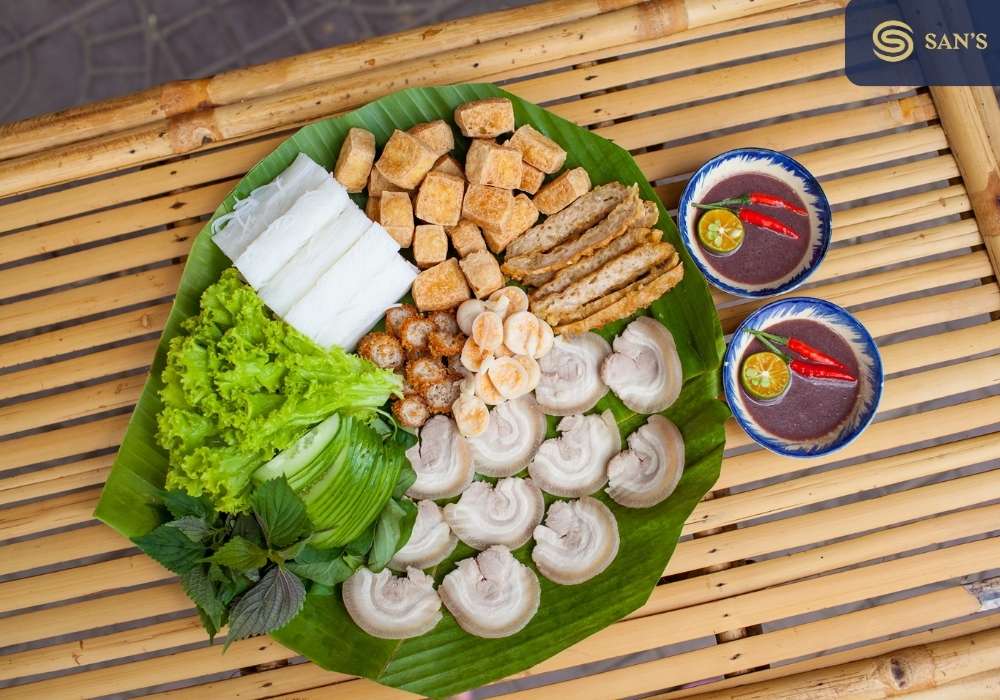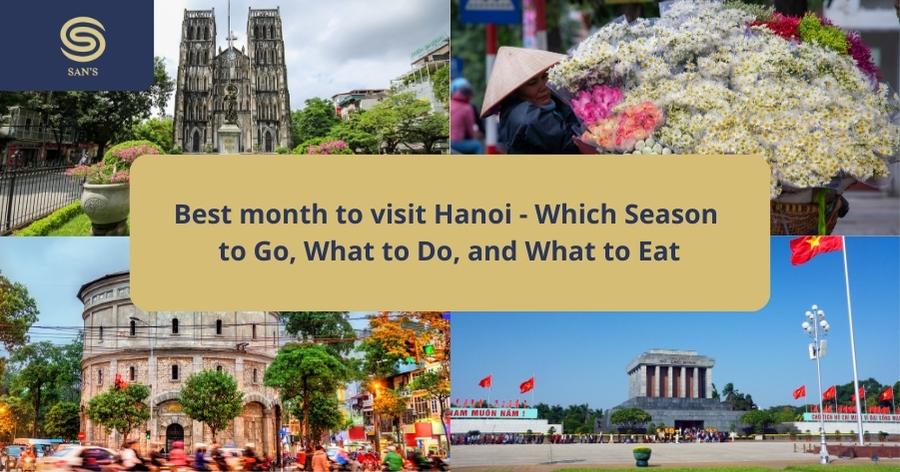Whenever the mention of Hanoi arises, what springs to mind? For numerous visitors, iconic landmarks like the Old Quarter often take center stage in their thoughts. However, today, let’s delve into another remarkable facet of the city – Hanoi culture food.
Upon arriving in Hanoi, what leaves the most lasting impression in this alluring and time-honored capital? While opting for renowned attractions is a natural choice, it’s worth acknowledging that these sites have gained considerable popularity due to the flourishing tourism. Perhaps you’re inclined to unearth something different, a facet that goes beyond the ordinary.
In this context, a Hanoi’s culture food tour presents an enticing option. Riding the wave of a recent and well-received trend, this article San Hotel will guide you through the realm of Hanoi’s food culture. Within these pages, we shall unveil the distinct symbols and splendors that comprise the essence of Vietnam’s capital.
What Makes It Stand Out?
As you are aware, every country and region possesses its distinctive culture, a factor that exerts a profound influence on various aspects of life. Culture plays a pivotal role in shaping lifestyles, character traits, mindsets, and even culinary practices. This very principle underscores why Hanoi stands apart from other cities and provinces within Vietnam.
Hanoi’s food culture, depicted through a lens of romance, paints a vibrant and captivating tableau, offering a glimpse into the lives of its inhabitants. The following dishes stand as revered icons that warrant your attention. As you embark on Hanoi tours, these gastronomic delights should find their way onto your must-try list.
Discover Must-Try Hanoi Food Culture
1/Pho
The foremost embodiment not just of Hanoi’s culinary culture but also of Vietnam’s gastronomic heritage is none other than “Pho“. This revered dish stands as the quintessential representation of traditional Vietnamese cuisine, with its roots tracing back to Hanoi.
-

Pho – Hanoi Culture Food
Comprising an exquisite ensemble of ingredients, “Pho” encompasses beef, rice noodles, onion, ginger, mung bean sprouts, basil, and cilantro. Yet, at its core, the irreplaceable element is the broth, meticulously crafted by simmering beef bones for an extensive duration. The culmination of flavors necessitates a minimum cooking time of at least 7 hours, ensuring the utmost excellence in taste.
Accompanied by condiments such as limes and fresh mint, the experience of savoring “Pho” can be further elevated with the inclusion of additional components like hot chili and soy sauce to cater to individual preferences. These intricate nuances combine to deliver an unforgettable sensation, leaving an indelible mark on your palate.
You can enjoy Pho at famous Hanoi restaurants such as:
- Pho Thin – 13 Lo Duc Street, Hoan Kiem District, Hanoi
- Pho Bat Dan – 49 Bat Dan Street, Hoan Kiem District, Hanoi
- Pho Suong – 24B Trung Yen Lane, Dinh Liet Street, Hoan Kiem District, Hanoi
- Pho Ly Quoc Su – 10 Ly Quoc Su Street, Hoan Kiem District, Hanoi
- Pho Gia Truyen – 49 Bat Dan Street, Hoan Kiem District, Hanoi
>> See more: Discover the Best Pho Places in Hanoi
2/Bun Cha
The second emblem of Hanoi’s food culture is none other than “Bun Cha.” So renowned is this dish that even President Obama opted to savor its delights during his visit. Aligning with the essence of Vietnamese cuisine, the cornerstone of this dish rests upon rice noodles. However, it is the tantalizing amalgamation of grilled fatty pork and broth that truly elevates its allure. Crafted from a harmonious blend of fish sauce, sugar, and either lemon or vinegar, these components coalesce to form the essence of “Bun Cha.”
-

Bun cha – Hanoi Culture Food
Visualize a satisfying serving of “Bun Cha” gracing your table – an abundant platter of rice noodles, accompanied by fresh vegetables, and a generous bowl of tangy broth. The luscious broth, enriched by the infusion of grilled pork, creates a symphony of flavors that encapsulates the quintessential tastes found across Vietnam. Without a doubt, Bun Cha stands as an essential gastronomic experience that should grace your palate as you embark on your Hanoi culture food tour.
You can enjoy Bun Cha at famous Hanoi restaurants such as:
- Bun Cha Huong Lien – 24 Le Van Huu Street, Hai Ba Trung District, Hanoi
- Bun Cha 34 Hang Than – 34 Hang Than Street, Ba Dinh District, Hanoi
- Bun Cha Dac Kim – 1 Hang Manh Street, Hoan Kiem District, Hanoi
- Bun Cha Hang Quat – 74 Hang Quat Street, Hoan Kiem District, Hanoi
- Bun Cha Sinh Tu – 57 Nguyen Khuyen Street, Dong Da District, Hanoi
>> See more: How to Eat Bun Cha: A Complete Guide
3/Banh mi
Continuing our culinary journey through the Hanoi culture food tour, we come to a beloved gem: Banh mi – an absolute must-try delicacy in Hanoi. Revered as one of the nation’s treasured street foods, Banh mi holds a steadfast position among Vietnam’s culinary delights. Imagine sinking your teeth into a delectable creation – a crisp and golden bread enveloping a savory ensemble of meat and pickled papaya. This harmonious blend of textures and flavors captures the essence of Vietnamese street food at its finest.
-

Banh mi – Hanoi Culture Food
The foundation of Banh mi is a crispy yet tender baguette, a legacy of French colonial influence that seamlessly marries with Vietnam’s culinary heritage. Inside this crusty exterior lies a world of possibilities. Succulent slices of various meats – from grilled pork and chicken to pâté and cured sausages – intertwine with fresh herbs and an array of pickled vegetables, most notably the tangy strands of papaya that add a refreshing crunch to each bite.
What sets Banh mi apart is not just its exquisite taste but also its versatility. With every vendor and street corner offering its unique twist, the variations are boundless. Some may add a fried egg or a sprinkle of chili for an extra kick, while others might incorporate regional ingredients to craft a distinct local flavor.
>> See more: Top 5 Best Banh Mi in Hanoi: A Foodie’s Ultimate Guide
4/Bun dau mam tom
Adding to the roster of renowned dishes is “Bún đậu mắm tôm” – a culinary gem that finds its roots in the heart of Hanoi’s food culture. In a nation where rice cultivation is a way of life, and Vietnam stands as one of the globe’s top rice exporters, it’s no surprise that rice noodles take center stage in this delicacy.
-

Bun dau mam tom – Hanoi Culture Food
Diverging from the path of “Bún Chả,” “Bún đậu mắm tôm” foregoes grilled pork to showcase a medley of flavors that reflect Hanoi’s culinary diversity. Within its embrace, you’ll discover the delightful ensemble of fried tofu, boiled pork, and the pungent allure of fermented shrimp sauce. A symphony of textures and tastes awaits as you engage with each element, coupled with a selection of fragrant herbs – cilantro, basil, and mint – that contribute to a delightful harmony.
However, a word of caution: fermented shrimp sauce may not be for the faint of heart. Its distinct aroma might challenge even the most adventurous palate. Yet, it’s precisely this unique characteristic that adds to the tapestry of Hanoi’s food culture, embracing flavors that may evoke a range of emotions, from curiosity to delight. As you partake in “Bún đậu mắm tôm,” you’ll not only experience an extraordinary dish but also immerse yourself in the dynamic and diverse world of Hanoi’s gastronomic landscape.
You can enjoy Bun Dau at famous Hanoi restaurants such as:
- Bun Dau Mam Tom Hang Khay – 31 Hang Khay Street, Hoan Kiem District, Hanoi
- Bun Dau Ngo Tram – 1B Ngo Tram Street, Hoan Kiem District, Hanoi
- Bun Dau Trung Huong – 49 Phat Loc Lane, Hoan Kiem District, Hanoi
- Bun Dau Co Tuyen – 31 Lane 29 Hang Khay Street, Hoan Kiem District, Hanoi
- Bun Dau Goc Da – 4 Ly Thuong Kiet Street, Hoan Kiem District, Hanoi
5/Ca Phe Trung (Egg Coffee)
Concluding our delightful journey through the Hanoi Street Food Tour, we arrive at a distinctive finale – egg coffee, a creation that originated right here in Hanoi, Vietnam. Emerging in the late 1940s, this exceptional concoction has since captivated the hearts of locals and visitors alike, solidifying its status as an essential specialty to experience in Hanoi.
-

Egg coffee – Hanoi Culture Food
Indulging in a cup of egg coffee unveils a multi-layered sensation, a symphony of flavors that intertwine to create a truly unique drinking experience. With every sip, you’ll encounter the velvety richness of egg yolk harmonizing with the robust bitterness of coffee. This combination presents a delightful contrast that’s simultaneously indulgent and invigorating.
As you savor egg coffee, you’re not merely enjoying a beverage; you’re immersing yourself in a piece of Hanoi’s history and culture. The story behind its creation, the meticulous craftsmanship that goes into its preparation, and the warmth of the café settings that serve it – all contribute to an experience that encapsulates the spirit of Hanoi.
In the heart of Vietnam’s capital, egg coffee stands as a testament to the city’s ingenuity, its ability to blend tradition with innovation. It’s not just a drink; it’s a journey into the heart and soul of Hanoi, a fitting conclusion to a tour that has showcased the vibrant and diverse tapestry of Hanoi’s food culture.
You can enjoy Egg Coffee at famous Hanoi cafes such as:
- Cafe Giang – 39 Nguyen Huu Huan Street, Hoan Kiem District, Hanoi
- Cafe Dinh – 13 Dinh Tien Hoang Street, Hoan Kiem District, Hanoi
>> See more: Best egg coffee in Hanoi: 8 addresses and experiences
Here is the “Hanoi Culture Food: The Signature Taste of Vietnam’s Capital”. Wishing you a delightful trip to Vietnam! If you’re visiting Vietnam and the capital, Hanoi, you can book a room at San Hotel at the best prices here!





